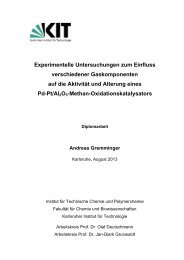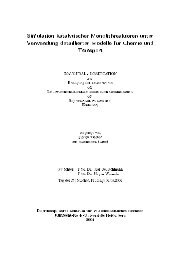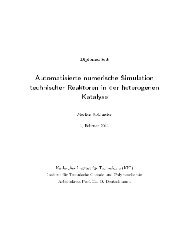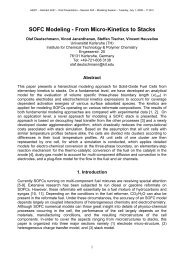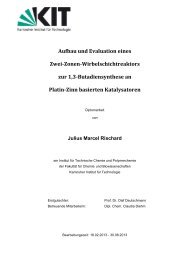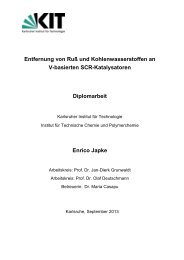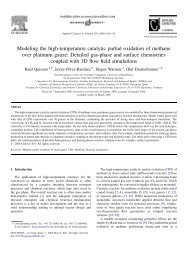Fuel Processing for Fuel Cells - Institut für Technische Chemie und ...
Fuel Processing for Fuel Cells - Institut für Technische Chemie und ...
Fuel Processing for Fuel Cells - Institut für Technische Chemie und ...
Create successful ePaper yourself
Turn your PDF publications into a flip-book with our unique Google optimized e-Paper software.
Author's personal copy<br />
20 Torsten Kaltschmitt and Olaf Deutschmann<br />
et al., 2008). Several technologies are available to provide ultra-clean hydrocarbon<br />
primary fuels, but it has become apparent that adsorptive desulfurization<br />
technologies are the best in terms of cost (van Rheinberg et al., 2011).<br />
Adsorptive desulfurization is a widely used technology <strong>for</strong> the removal of<br />
sulfur from fuels to a level of ultra-clean quality. Simplicity and adaptability<br />
make this technology flexible and easy to integrate into the process due to<br />
the fuel processor and fuel cell type. A broad variety of sorbent materials are<br />
available on the market, ranging from zeolites and activated carbon over<br />
catalysts containing transition and precious metals to metal oxides, <strong>for</strong><br />
example, ZnO. Actual research focuses on the development of more<br />
sulfur-tolerant catalyst systems <strong>for</strong> fuel processors and anode materials<br />
<strong>for</strong> fuel cells, requiring less precleaning of the fuel and thereby minimizing<br />
the balance of plant (BOP) and cost reduction.<br />
Pre-re<strong>for</strong>ming is per<strong>for</strong>med to crack higher hydrocarbon species into<br />
hydrocarbons ranging from C 1 to C 6 as they have better re<strong>for</strong>ming characteristics<br />
in ATR compared to long-chain and aromatic compo<strong>und</strong>s<br />
(Borup et al., 2005). Muradov et al. have reported about a novel combined<br />
pre-re<strong>for</strong>ming–desulfurization process <strong>for</strong> the conversion of high-content<br />
sulfur diesel fuel to hydrogen-rich re<strong>for</strong>mat suitable <strong>for</strong> fuel cells<br />
(Muradov et al., 2010). The pre-re<strong>for</strong>mer uses hydrogen recycled from<br />
the fuel processor/purification unit to convert sulfur-enriched diesel fuel<br />
(3180–5240 ppmw) into short-chain hydrocarbons, mainly propane, and<br />
H 2 S. Muradov et al. assume that 13–16% of the hydrogen fraction needs to<br />
be used <strong>for</strong> recycling in their pre-re<strong>for</strong>mer unit in order to convert diesel<br />
fuel to propane and butane. As pre-re<strong>for</strong>ming catalyst, they use a mixture<br />
of zeolite and Ni-Mo/alumina catalyst at 400–500 C with pressures<br />
aro<strong>und</strong> 14 bars. The desulfurization of the pre-re<strong>for</strong>mer effluent gas was<br />
per<strong>for</strong>med with adsorption technology using an aqueous ferric sulfate<br />
solution, which led to an overall desulfurization yield of 96–98%, with<br />
100 h, and coke <strong>for</strong>mation on the catalytic surface as well as deactivation<br />
of the pre-re<strong>for</strong>mer was observed, depending on the process parameters.<br />
Since primary fuels are directly usable <strong>for</strong> re<strong>for</strong>mer applications<br />
such as SR, ATR, or catalytic partial oxidation (CPOX), only desulfurization<br />
is necessary to protect the sulfur-sensitive active sites in most re<strong>for</strong>ming<br />
catalyst. Pre-re<strong>for</strong>ming appends another reactor unit to the complete<br />
fuel processor system and their application is doubtful due to coking/<br />
regeneration, volume, and weight increase in mobile applications.<br />
4.2 Conversion of hydrocarbon fuels to hydrogen<br />
The reactants in fuel processing, that is, the fuel C x H y O z , steam, H 2 O, and<br />
the oxidizer, O 2 , contain carbon (C), hydrogen (H), and oxygen (O) atoms.<br />
From the point of thermodynamic equilibrium, a convenient way <strong>for</strong>



